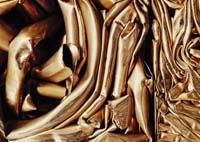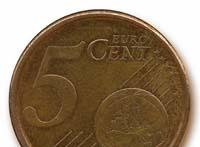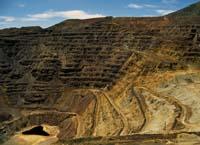Copper is not forever

The Vikings arrived on the Welsh coast and met a snake shaped hill. They called him Great Orme, that is, harra, sea serpent or something like that. It was a beautiful place, apparently eye-catching, in which, besides beauty, the hill offered something else: the metallic copper in its entrails.
But that copper was exploited long before the Vikings arrived. 1,600 years earlier at least. In fact, according to current archaeologists, Great Orme was the largest copper mine of the Bronze Age. About six kilometers excavated at that time have lasted until today. After analysis of these tunnels, experts estimate that 1,769 tons of copper were extracted in the Bronze Age. To be in the Neolithic is a great brand.
This mark is, in short, an indicator of the history of copper and the importance that the bronze acquired in the Neolithic. It is nothing new: The Bronze Age itself means the same. And bronze is only an improved copper, a 90% copper alloy, harder than copper itself, easier to melt and more adaptable. Like the use of copper, it was a great step forward with regard to the use of stone and wood, bronze was also a great advance with respect to copper. Until iron was imposed, bronze was the most useful metal that man knew.
Large numbers
Copper sources, such as Great Orme, were perfectly exploited to get the bronze. However, the amount of copper extracted is no more than a fragility compared to copper production in a current mine.

The largest copper mine in the world is that of Chuquicamat, in Chile, where more than six hundred thousand tons of copper are extracted annually, that is, 350 times more copper than that extracted from the Great Orme mine in a single year in 1,200 years. And as if it were not enough, it should be taken into account that in the Chuquicamata mine there is not metallic copper, but the mineral with copper, which is calcopirite; to obtain from this beta a kilo of copper, it is necessary to extract at least 85 kilos of calcopirite. These numbers are very representative.
To all this we must add the footprint of copper consumption. According to data from the international organization ICSG, in the first eleven months of 2005 154,000 tons of copper were consumed more than those produced. And that's not new, it's the same trend as in previous years. The most developed countries consume copper disproportionately and now, in addition, other countries, especially China, India and Russia, are increasing this consumption. Faced with this situation, rich Western countries begin to worry.
Electrical element electrical element
There are several ways to look at this problem. One of them is technological reflection and the first step can be to understand why we have so much dependence on copper. It is a technological reflection above all
Copper is also used in all electrical and electronic devices.

In fact, in the case of copper, the most sudden change that has occurred since the Bronze Age has been the use of electricity. But copper has other applications: tube making, kitchen utensils, is part of some alloys, serves to maintain various structures, car radiators, etc. However, 45% of the copper currently used is used in electrical components.
Why? Because copper has very good properties, almost perfect. The manufacture of copper threads is simple, is a good conductor, resistant, is not a magnetic material and corrosion resistant. It is not little.
That is why it is very abundant. For example, a computer has about two kilos of copper and a car has at least 20 kilos. The sum of the cables of a commercial plane would allow to form a copper thread of approximately one hundred kilometers. If copper were exhausted, it would be a huge crisis in this society.
Calculations Calculations Calculations
But, will the copper be finished? Is that risk real? It is very difficult to respond, but some have tried it. In the United States, for example, the ecologist of Yale University, Thomas Graedel, has worked hard. In his opinion, the answer is affirmative, the copper will be exhausted and calculations have been made to know when it will occur.

First, the amount of copper extracted in North America (Canada, United States and Mexico) has been calculated. Throughout the twentieth century. The result has been removed from the amount of copper converted into garbage. According to them, the result is a good indicator of current consumption, since in North America very little copper has been imported. In the twentieth century. This consumption has been calculated differently. The second study analyzes the copper of a single municipality: The same municipality in which is the University of Yale, New Haven.
In both cases, a similar result has been obtained. The average use of copper per person in North America is 150 kilograms. Surely the result can also serve for Western countries.
Today many peoples consume much less copper, but it is difficult to say how this consumption will evolve. China, India and Russia are firing their consumption, but other countries can also grow economically for decades. That is very difficult to predict. For this reason, the ecologists of the University of Yale have made a drastic calculation. They calculate what would happen if all the inhabitants of the world consumed what they consume today in North America. Of course, they have valued the growth of the world population in the coming decades and have concluded that copper would be exhausted by 2050.
Although the calculation is done correctly, it is not based on the current consumption. But it is evident that nature cannot withstand for a long time the American or European consumption. In addition, the calculation does not refer to the energy, water and other resources necessary for the extraction of copper. Taking into account all these considerations, in addition to exhausting copper, ecologists would announce a huge ecological impact.
What can be done?

In recent years, many copper substitutes have been proposed, especially to replace electric cables. Optical fiber has been proposed for data transmission, the realization of electrical connections with the size of nanomoleculae, among others, wireless technology. But there is no solution that can replace copper. They are all more expensive, made of more fragile materials or generate other problems (increased radiation, safety problems, etc. ). Who knows, perhaps you can get a useful substitute, but for the moment technology does not allow the copper that is dispersed in the world to be replaced by something else.
So what? It is necessary to make a constant reflection; the ecologists of Yale University have said clearly that before or after you have to start recycling copper. It is a very simple concept, in short, in nature all elements have a cycle. At the end of the useful life of what is consumed, we should look for some way to turn it back into raw material.
It is a simple concept but to be implemented. There are many companies that are developing copper recycling systems. As always, it is a money account; when the copper output of the cables is cheaper than underground extraction, then it will be recycled. That is the challenge.
Buletina
Bidali zure helbide elektronikoa eta jaso asteroko buletina zure sarrera-ontzian











